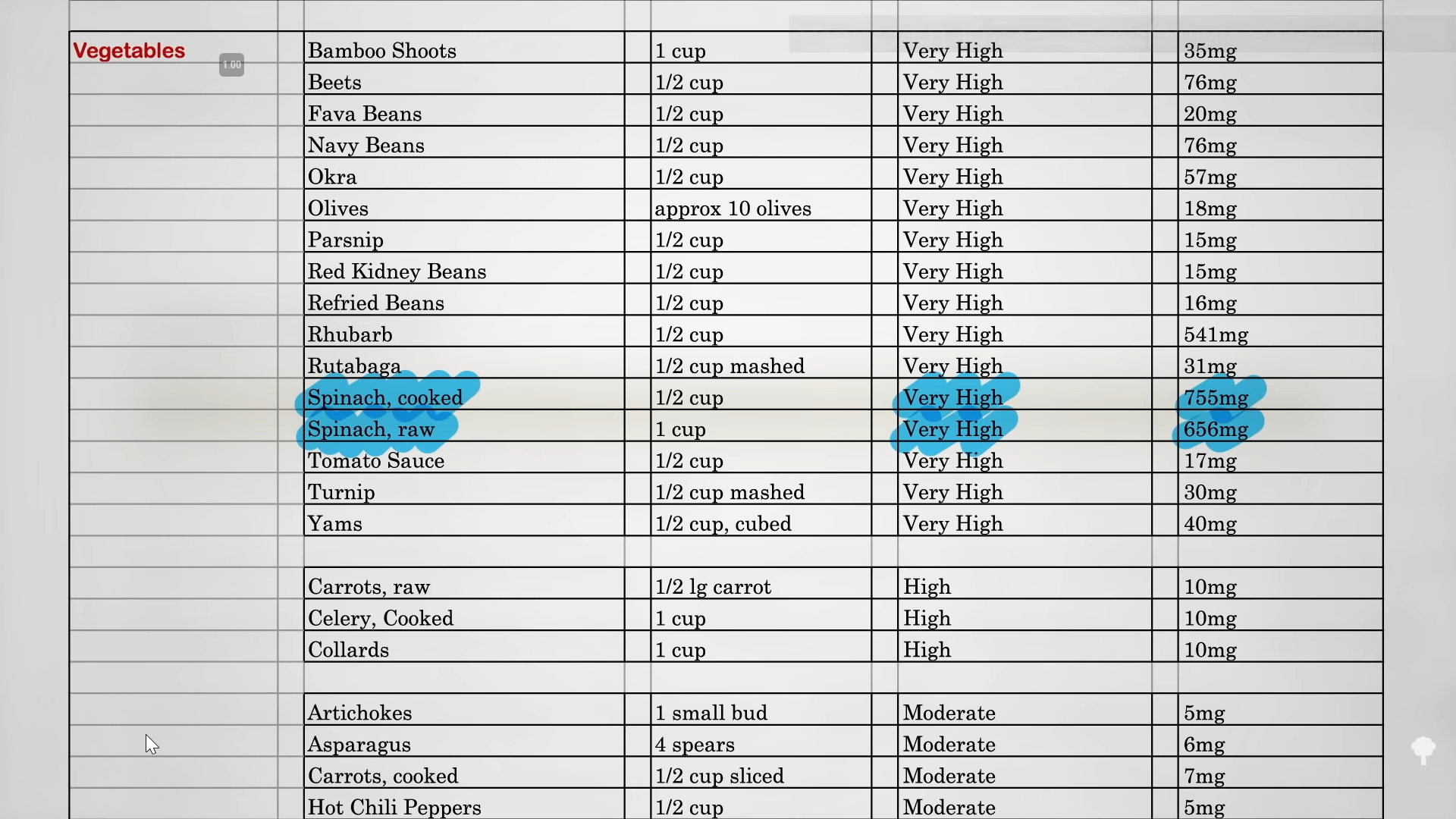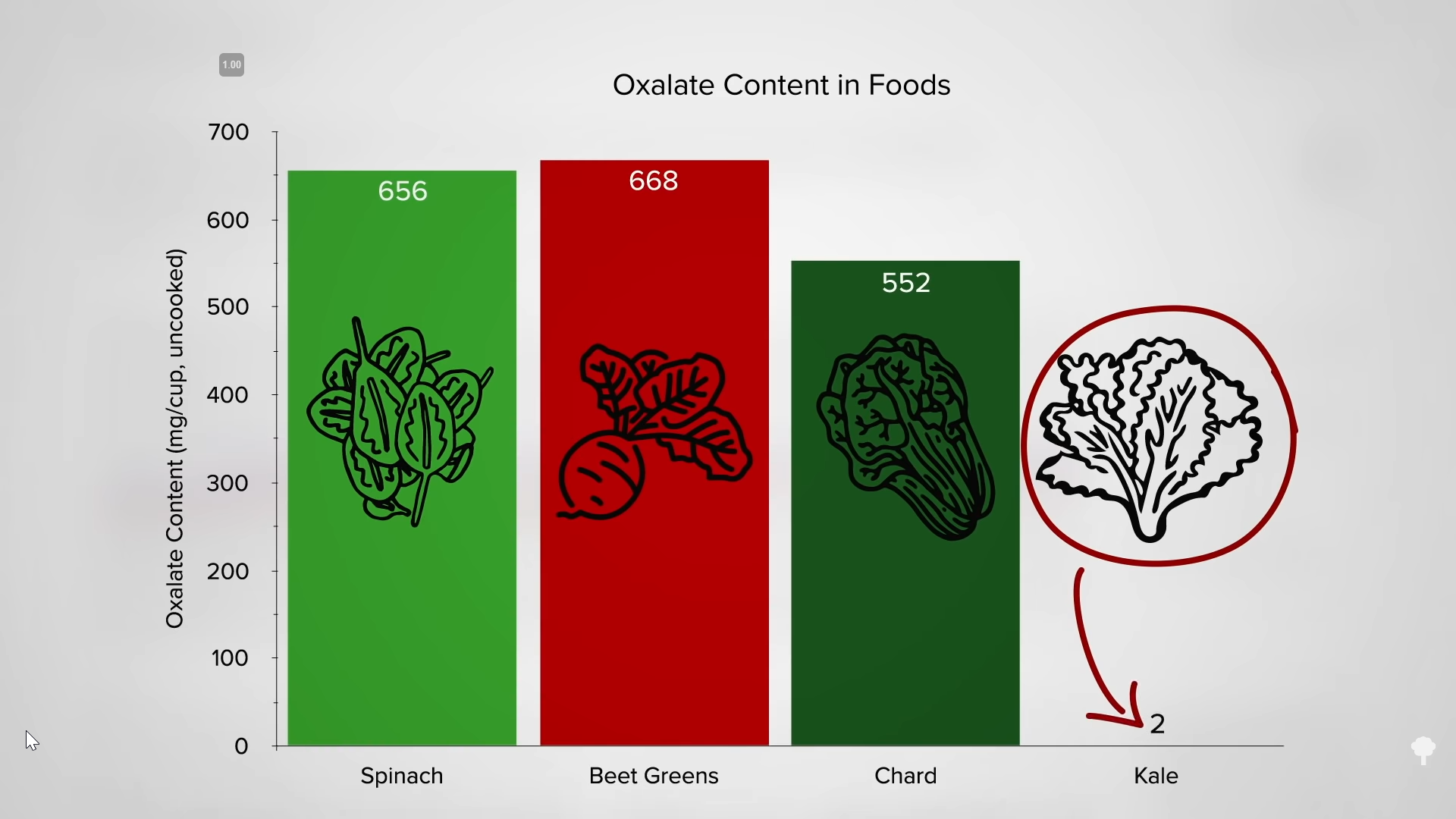Even though dietary oxalates may have a limited effect on the risk of kidney stones in most people, there are some predisposing factors that can put anyone at risk.
Kidney stones affect as many as one in ten people in their lifetime and can cause excruciating pain. (It makes me cross my legs just thinking about them.) Oxalate stones are the most common type, forming when the oxalate concentration in your urine gets so high it basically crystallizes out of solution like rock candy. Some foods, like spinach, have a lot of oxalates in them, as you can see below and in the table shown at 0:29 in my video Oxalates in Spinach and Kidney Stones: Should We Be Concerned?. Should we try to reduce our intake of oxalates to lower our risk? It turns out that people who do get stones don’t seem to eat any more oxalates on average than people who don’t get stones. It may be less what you eat and more what you absorb. People who are predisposed to kidney stones just appear to be born with a higher intestinal oxalate absorption. Their guts just really suck it up. “People who have hyperoxaluria—so-called ‘super absorbers’—can absorb 50% more oxalate than non–stone formers.”

Overall, the impact of typical dietary oxalate on the amounts of oxalates that end up in the urine “appears to be small.” In fact, even a “massive” dose of dietary oxalates typically only “results in a relatively mild increase” in the amount that makes it into your urine, as you can see in the graph below and at 1:21 in my video. A 25-fold increase in oxalate consumption doesn’t even double the concentration of oxalates flowing through your kidneys, so it is “indeed determined more frequently by genetic than environmental factors,” like diet. Still, until you get your first kidney stone, how do you know if you’re a super absorber or not? Is it safer just to generally avoid higher oxalate fruits and vegetables? People who eat more fruits and veggies may actually tend to get fewer kidney stones.

When researchers put it to the test and removed produce from people’s diets, their kidney stone risk went up. Removing fruits and veggies can make your dietary oxalate intake go down, but your body produces its own oxalate internally as a waste product that you may have more difficulty getting rid of without the alkalizing effects of fruits and vegetables on your urine pH. This may help explain why those eating plant-based get fewer kidney stones, but it also may be due to them cutting their intake of animal protein, which can have an acid-forming effect on the kidneys. We’ve known this for 40 years. Just a single can of tuna fish a day can increase your risk of forming kidney stones by 250 percent, whereas just cutting back on animal protein may help slash that risk in half.
Surely there’s some level of oxalate intake that could put people at risk regardless. There have been a few rare cases reported of people who drink green juices and smoothies getting oxalate kidney stones, though most had extenuating circumstances. In one case, however, a woman’s kidneys shut down after a ten-day juice cleanse, which included two cups of spinach a day. Normally, we might not expect a cup or two of spinach to cause such a violent reaction, but she had two aggravating factors: She had had gastric bypass surgery, which can increase oxalate absorption, and a history of prolonged antibiotic use. There’s actually a friendly bacterium called oxalobacter that we want in our colon because it eats oxalate for breakfast, leaving even less for us to absorb, but it can get wiped out by long-term, broad-spectrum antibiotic use.
Even with those two aggravating factors, she probably wouldn’t have run into a problem if she had used something other than spinach (or beet greens or swiss chard) when making the smoothies for her cleanse. As you can see in the graph below and at 3:53 in my video, compared to that trifecta of high-oxalate greens, kale has hundreds of times fewer oxalates than all three. She would have had to have juiced in excess of 650 cups of kale every day to get a comparable dose—more than 6,000 cups of kale over the ten days of her cleanse.

Are the three high-oxalate greens only a problem for people with extenuating circumstances or who are otherwise at high risk? What if you cook the greens? And, how much is too much? I answer all of those questions in my video Kidney Stones and Spinach, Chard, and Beet Greens: Don’t Eat Too Much.
It takes a while for videos to be made, so when I discover something like this in the research, I immediately go to our social media channels to alert people, as I did with this cautionary note on high-oxalate greens. So you don’t miss any critical “heads-up” info like this in the future, follow us on Facebook, Instagram, or Twitter, and subscribe to our free monthly newsletter.
For more information on kidney stones, see my videos Flashback Friday: How to Prevent and Treat Kidney Stones with Diet.
